October I seemed to spend a long time struggling to make pictures in darkness and rain, particularly at several of what turned out to be a weekly fixture covering the Poor Doors protests outside the hugely expensive One Commercial Street flats in Whitechapel High St at Aldgate, just on the edge of the City of London.
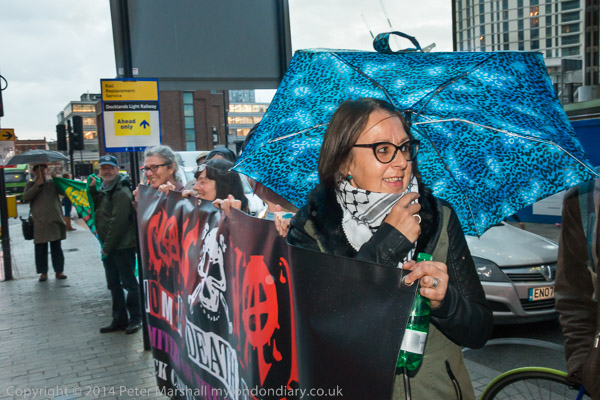
It wasn’t really quite dark when I took this- and other pictures in Poor Doors Musical Protest
One solution (of sorts) to darkness is to use flash, and I’ve kind of got used to that, even if things go infuriatingly wrong at times. But using flash in rain is a problem, as all the raindrops glow in the flash, particularly those closer to the camera (as the light falls off with the square of the distance.) My flash units aren’t waterproof either, and using them in wet conditions without some kind of protection can lead to expensive repairs – and even the possibility of getting 400 volts when you least expect it.
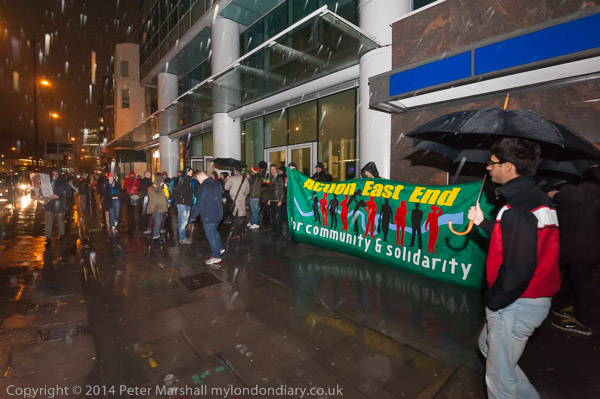
A week later it was darker and raining rather more – Class War Poor Doors Week 12
Flash is often infuriating in any case, and there are some very good web sites about using it which suggest various creative set-ups, none of which are particularly appropriate to the kind of work that I do. For that you need quick and dirty flash, but there are a few things to bear in mind which can improve matters. I suspect I’ve mentioned all this before, but here goes with my 10 flash tips.
- Use high ISO to avoid blackness around the close bits your flash can light up. Mostly at night with flash I work at ISO1600 or ISO3200.
- If your flash has a diffuser built in, use it for wide-angles unless you want ‘creative’ vignetting. For longer lenses you can use it for close subjects. The little built-in white plastic bounce reflector helps too – but only at fairly short range, when you can then angle the flash head up at 45 degrees.
- Work with your camera in manual mode and your flash in auto TTL mode (assuming you can – it works with my SB800s)
- Usually a shutter speed of 1/30 or 1/60 will do fine. Mostly I also work with my rather slow lenses more or less wide open too. Aim to get an exposure without flash that is perhaps 2-4 stops under.
- Try to underexpose with the flash too, but only by around 1 stop. If you give correct exposure you will get pictures that don’t look as if they were taken at night. If I’m working without flash I generally need to underexpose by 1-2 stops
- Most night scenes – at least in cities – will contain lots of light sources which seriously muck up your camera’s metering. Best work in manual and check the results, adjust as needed, then leave alone until you move into a differently lit area.
- When possible make use of the uneven light spread your flash will give by angling the flash head away from the closer parts of the subject.
- Sometimes it pays to use your left hand as a flag to shade parts of the subject.
- Work in RAW, as you are going to need considerable post-processing for best results.
- Never let people see your flash pictures until you’ve sorted them out in post-processing!
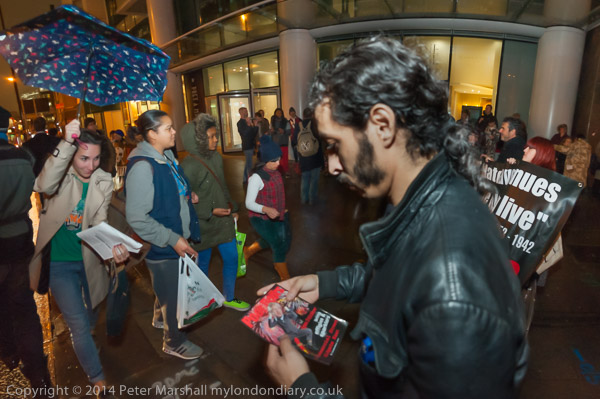
We did have one dry week, but then it rained again – another Wet night at Poor Doors
Nikon also have some kind of random fault generator, that will result in the occasional image being hopelessly over-exposed. It might help to make sure flash and hotshoe contacts are clean and that you have pushed the flash right on and locked it in position. But you will still get the odd random white-out (or at least I do) and the occasional random non-flash image with burnt out highlights. Its just to keep you on your toes.
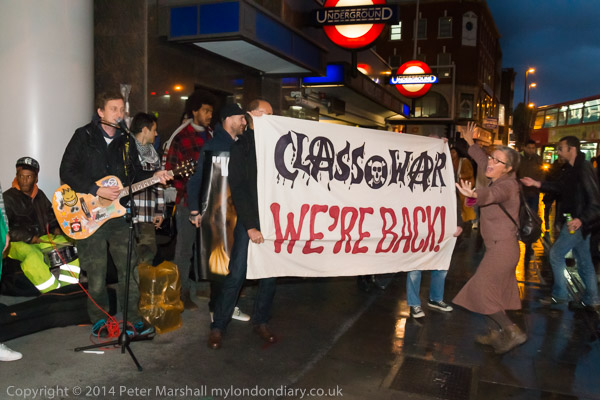
Of course there are some faults for which only the photographer is to blame. Like taking a second picture before the flash has had time to recycle, which I manage frequently. Or forgetting that any exposure compensation for flash set on the camera adds on to that set on an external flash unit…
And while flash actually built into the camera may sometimes be a good idea, it’s largely a marketing point. Of the five lenses that I normally use on the Nikons it actually only works sensibly with one of them (and the one I uses least) the 20mm f2.8; with all the other lenses except the fisheye get a large shadow in the lower part of the frame from the lens. For the 16mm fisheye it’s also generally useless as it only illuminates a central oval in the frame.
I always thought that, as the SB800 manual says the flash diffuser is needed to provide proper illumination for 14mm and 17mm lenses, this meant that there was no way the flash would give a wide enough coverage with the 16mm fisheye. So I’d never tried it before these occasions. To my surprise it actually works quite well, and is slightly better still if you also use the bounce card. Used out of doors, recycling times will be around the maximum – and NiMH rechargeable batteries the only sensible choice. When I remember, adding the optional 5th battery really helps, bringing the recharge time down to under 3 seconds, almost as fast as the best external power supplies.
Having fitted an external flash into the hot-shoe, it becomes possible to only slightly raise the built-in flash. Just a little, so it is difficult to notice, but it is still enough to mess up flash exposures completely. So much so that I keep it permanently taped down, only for emergency use.
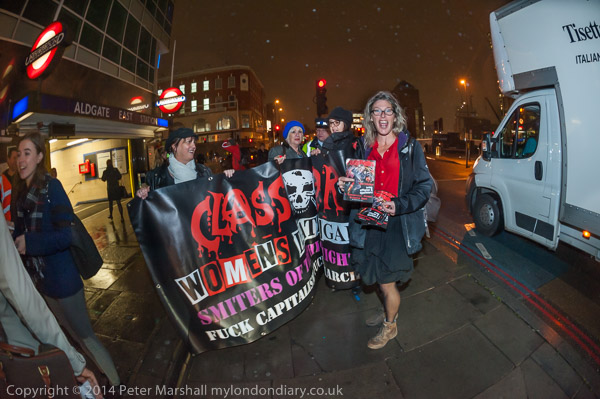
Uncorrected Fisheye and flash
But flash and rain is still a problem. As an alternative to flash I have a couple of cheap LED light sources, the more powerful with 9 rows of 16 LEDs, a total of 144 LEDs. It makes quite a good torch for looking underneath furniture, but as a light source for taking pictures it is far too weedy. There are more expensive units around, but I’ve yet to try them, though I have at times ‘borrowed’ the light from the larger units wielded by professional videographers.
But in the end I’ve often found myself trying to work just with available light, and wishing that I had lenses for the Nikons like some of those I used to use, particularly the 35mm f1.4 Summilux. Neither the 16-35mm f4 nor the 18-105mm f3.5-f5.6 is much of a lens in low light, and most of the time I find myself using the 16mm f2.8 fisheye, or, if I’ve remembered to put it in my camera bag, the 20mm f2.8. I’ve had most success with the 16mm (not least because I’ve almost always got it with me) but I’d still like a really fast wide lens for use on dirty nights. The only real choice I can see is the Nikon 20mm f1.8G AF-S but its a little on the expensive side.